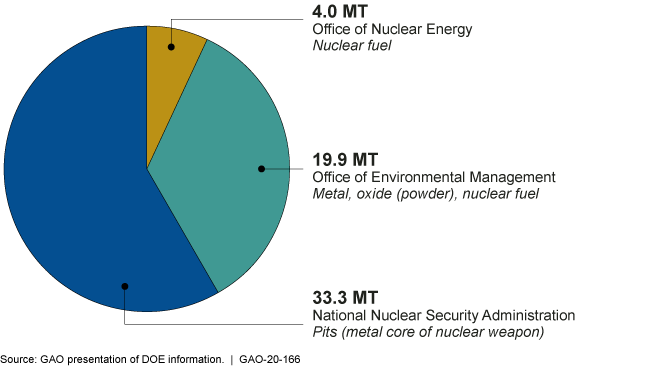Surplus Plutonium Disposition: NNSA's Long-Term Plutonium Oxide Production Plans Are Uncertain
Fast Facts
The National Nuclear Security Administration manages 57.2 metric tons of surplus plutonium. NNSA's plan was to:
Convert much of it into a plutonium oxide powder in New Mexico
Ship the powder to South Carolina for dilution
Ship diluted oxide back to New Mexico for disposal
These plans are uncertain because of competing demands at the conversion facility. Also, shipments to South Carolina may be delayed because NNSA is prioritizing plutonium removal from the state in order to meet a legal requirement. NNSA officials said they are working on addressing these issues, for example, by speeding up plutonium shipments out of South Carolina.
Metric Tons of Surplus Plutonium Managed by 3 Department of Energy Offices

Pie chart showing NNSA has the majority of surplus plutonium of the 3 DOE offices
Highlights
What GAO Found
Of the Department of Energy‘s (DOE) inventory of surplus plutonium, about 43.8 metric tons (MT), or 77 percent, is plutonium metal that could be converted to plutonium oxide for dilution and disposal. Of this amount, the National Nuclear Security Administration (NNSA) manages 33.3 MT in the form of pits, DOE's Office of Environmental Management (EM) manages 6.5 MT, and DOE's Office of Nuclear Energy manages 4 MT in the form of reactor fuel. EM manages another 11 percent, or 6.4 MT, of DOE's surplus plutonium that is already in oxide form. Most of this is suitable for dilution and disposal at the Waste Isolation Pilot Plant (WIPP), a repository in New Mexico. An additional 12 percent, or 7 MT, of DOE's surplus plutonium is contained in spent nuclear fuel that is planned for disposal in a geologic repository. See figure.
The Department of Energy's (DOE) Surplus Plutonium, of Which 43.8 Metric Tons (MT), or 77 Percent, Could Be Converted to Plutonium Oxide

NNSA's 2018 conceptual plan calls for converting 26.2 MT of this surplus plutonium into oxide by 2045. In September 2019, NNSA approved the production of about 1.2 MT of plutonium oxide through 2025 at its Los Alamos National Laboratory (LANL) located in New Mexico. However, plans for converting additional surplus plutonium into plutonium oxide are uncertain because of two issues. These issues include NNSA's still-developing plans for new pit production, which will also take place at LANL, and issues surrounding the agency's ability to ship newly produced plutonium oxide for dilution to DOE's Savannah River Site (SRS) in South Carolina. According to agency officials, NNSA and DOE are taking several actions that, if successfully implemented, are designed to allow NNSA to meet its long-term plutonium oxide production goals. These actions include continuing to review plutonium oxide and pit production plans, increasing plutonium storage at LANL, reducing the amount of SRS's surplus plutonium, and accelerating the shipment of diluted plutonium from SRS to WIPP.
Why GAO Did This Study
The United States has 57.2 MT of weapons-usable plutonium that it has declared surplus and that still requires disposition. This plutonium exists in various metal and non-metal forms, including pits—the central core of a nuclear weapon. To prevent insidious use of this plutonium, DOE plans to disassemble pits into metal; convert the plutonium metal to plutonium oxide, a powder-like substance; dilute it with inert material; and dispose of it at WIPP. In May 2018, NNSA issued a plan conceptualizing the dilution and disposal of 34 MT of surplus plutonium at an estimated cost of $19 billion over the next 3 decades. Under this conceptual plan, pit disassembly and production of plutonium oxide would take place at one facility and dilution would be performed in another, with both operations expanding over the next decade.
GAO was asked to review DOE's plans for plutonium oxide production to dispose of surplus plutonium. This report (1) examines the amount of surplus plutonium in DOE's inventory that could be converted to plutonium oxide for dilution and disposal and (2) examines DOE's capacity to produce plutonium oxide. GAO reviewed the inventory of surplus plutonium, plutonium oxide production requirements and production capacity, and DOE planning documents, and interviewed DOE officials.
For more information, contact David Trimble at (202) 512-3841 or TrimbleD@gao.gov.
